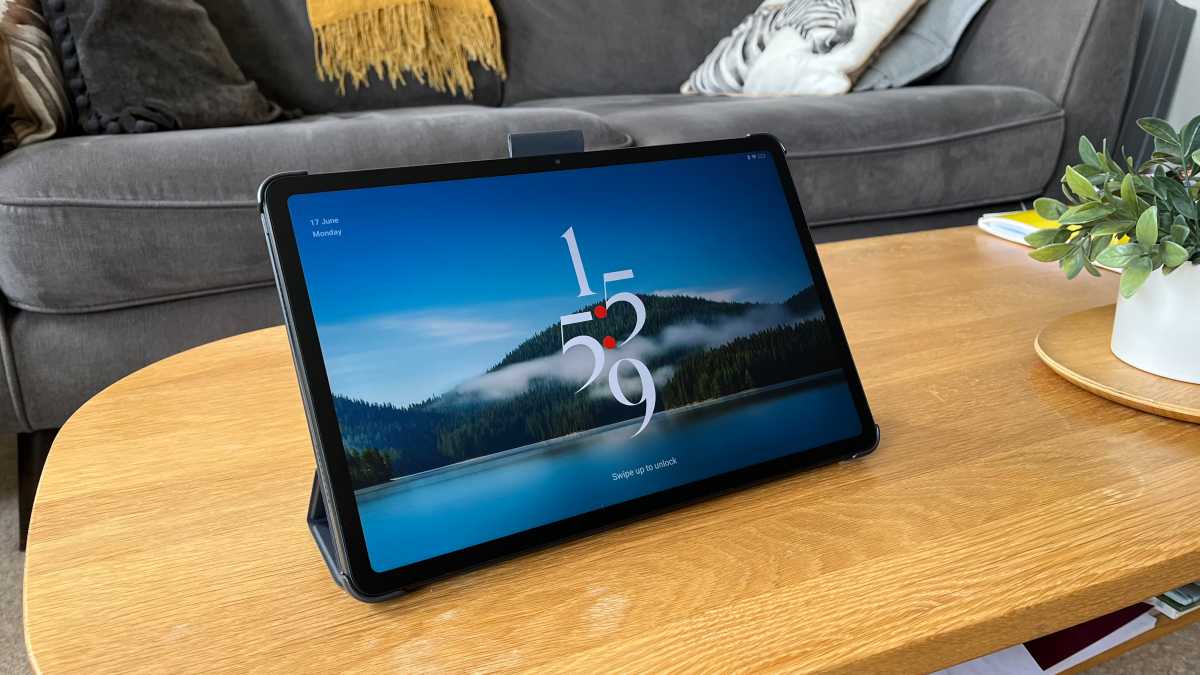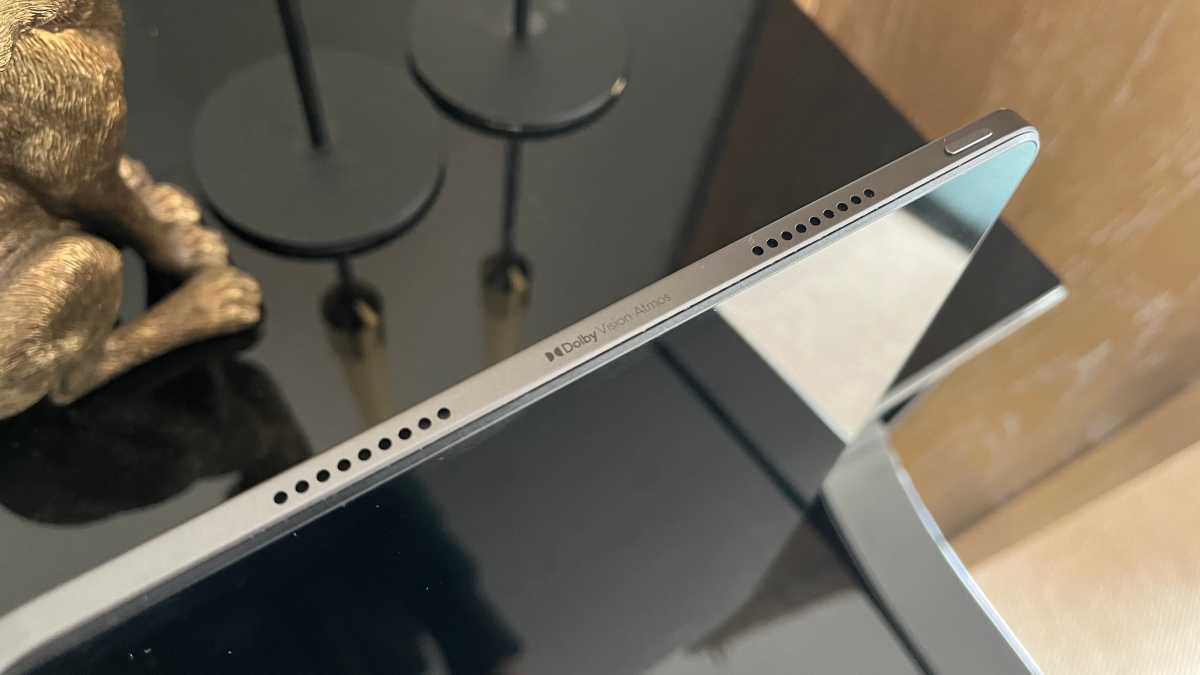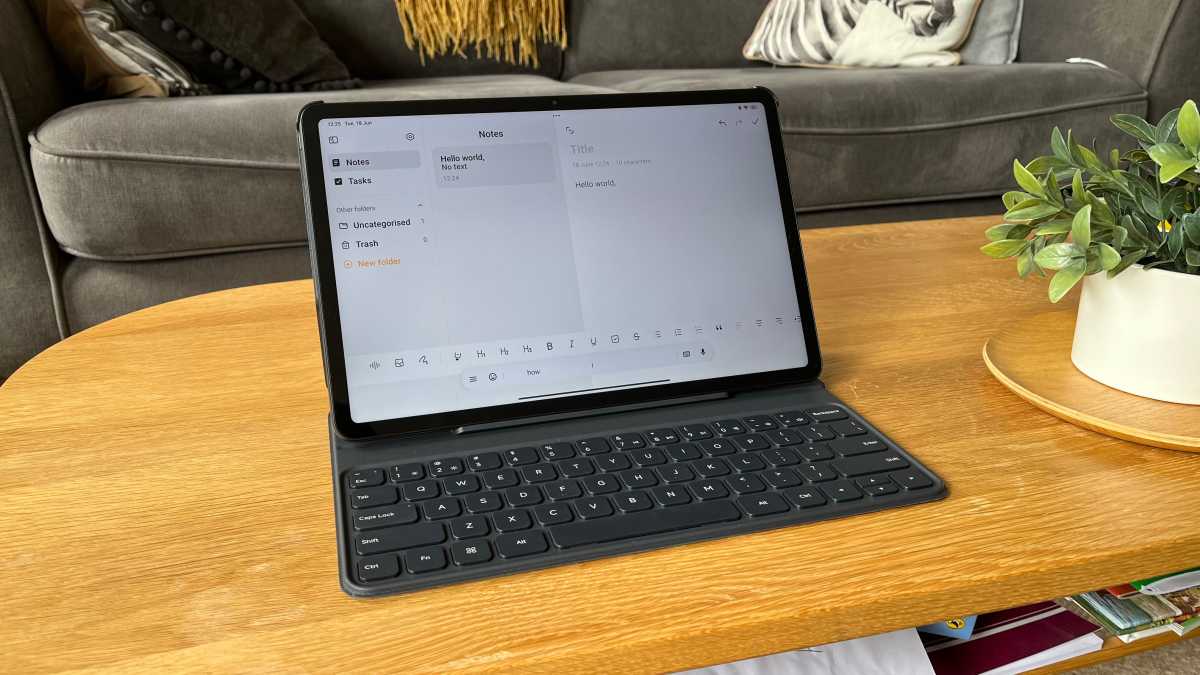Expert’s Rating
Pros
- Dependable battery life
- Large 120Hz screen
- Solid aluminium build
- Handy stylus support
- Excellent quad speakers
Cons
- Occasional lags in performance
- Camera is limited
- Cluttered software
Our Verdict
The Poco Pad is an affordable gateway into the world of Android tablets, featuring a high-quality display, capable Snapdragon 7s Gen 2 chip, stylus support and a huge 10,000mAh battery. It isn’t quite as high-performing as some of its more premium counterparts, but that’s to be expected at this price.
Xiaomi’s Poco brand has been steadily building a reputation for high-performing budget smartphones over the past few years, but it’s decided 2024 is the time to expand into budget tablets.
Such a move comes at a time when mid-range and budget tablets are plentiful, with Xiaomi Pad 6, Lenovo Tab M11, Samsung Galaxy A9 and Google Pixel Tablet all offering something for users who want an Android tablet without having to spend too much.
While the Poco Pad does obviously move away from the compact form of the F6 and X6 Pro smartphones, it retains many of the hallmarks featured in these Poco devices, including a big 120Hz display, strong battery life, and solid performance. But just how much value for money does it offer? And is it worth choosing over more established names?
We put it to the test in this review, discovering just how much of a premium tablet experience Poco can offer for a fraction of the usual price.
Design & Build
- Squared design with aluminium frame and rear
- Pin-hole selfie camera mounted in bezel
- No IP rating
The Poco Pad sports an understated yet quietly stylish design, characterised by flat sides, rounded corners, and a sleek aluminium frame.
The tablet’s rear features a vertical lens-and-flashlight array in its top-left corner, with the rest of the surface taken up by nothing more than the Poco logo in the bottom left. As for the front, it’s equally minimal, with the 12.1-inch display surrounded by fairly thick 8mm bezels, which on the rear camera side house the selfie lens.
The tablet is available in only two colours, Grey or Blue. These both fit the pared-down aesthetic of the device well, even if the absence of livelier options may disappoint some prospective buyers.

Simon Chandler / Foundry
Still, the Poco Pad certainly punches above its weight in the appearance department, although in terms of literal weight, it’s actually relatively heavy. Compared to the Samsung Galaxy Tab A9 and Lenovo Tab M11, which weigh in at 332g and 465g respectively, the Poco Pad tips the scales at 571g (or 1.26lbs).
The Poco Pad sports an understated yet quietly stylish design
Stemming from the bigger display and battery, this extra baggage arguably adds to the premium feel of the device. And given that the weight is evenly distributed, holding the tablet for prolonged periods of time doesn’t really feel like a chore.
The Poco Pad will also prove fairly durable, as it comprises a sturdy aluminium frame and a Gorilla Glass 3 screen. One downside, however, is that there’s no official IP rating for water and dust resistance, although this is pretty much standard for the vast bulk of tablets.
Screen & Speakers
- 12.1-inch IPS LCD display
- 120Hz refresh rate
- Quad speakers
Perhaps it’s not surprising for a tablet at this price point, but the Poco Pad’s display is a mixed bag. On the one hand, its 12.1-inch screen is big and bright, and it even comes with an adaptive 120Hz refresh rate, making it nice and smooth for scrolling.
On the other hand, its use of an IPS LCD panel means it lacks the sharpness and vividness of more luxurious OLED tablets. Sure, you can easily watch Netflix, YouTube and other streaming services on the device thanks to the size of its screen, but if you’re a proper film buff, you’ll miss some of that clarity and detail.

Simon Chandler / Foundry
This is despite the fact that its resolution is pretty generous at 2560 x 1560 pixels, which provides roughly 249 pixels per inch. This is better than that offered by many other tablets (including something like the Samsung Galaxy Tab S9), yet watching on the Poco Pad never really takes your breath away, even if it is mostly good enough.
The Poco Pad’s display is a mixed bag
However, due to the Poco Pad boasting such an ample 12.1-inch display, it does make for more comfortable web browsing and general productivity. This isn’t something that many tablets in its range can lay claim to, so even if its screen isn’t dazzling, it definitely performs.

Simon Chandler / Foundry
What also performs are the Poco Pad’s four stereo speakers, which support Dolby Atmos surround sound. It accordingly produces some appreciably full and rich audio, with a nice balance of EQs (equalizers) and the ability to layer clearly.
While it may not reach the volumes that some people would like, it’s more than enough to serve for casual home listening and viewing.
Specs & Performance
- Qualcomm Snapdragon 7s Gen 2
- 8GB RAM and 256GB storage
- Slot for microSDXC card: expandable up to 1.5TB
The Poco Pad hides the Qualcomm Snapdragon 7s Gen 2 under its hood, with the mid-range chip a more recent sibling to the 7 Gen 1 and 7+ Gen 2, which are all built using a 4nm manufacturing process.
In theory, this should make the Poco Pad highly capable for a device in its range, with the tablet also carrying 8GB of LPDDR4X RAM.

Simon Chandler / Foundry
Yet in practice, the Poco Pad isn’t as nimble as you might imagine. Yes, everyday tasks and apps are usually handled with relative ease, with the device serving well for browsing, social media and light productivity.
But when you move up to games, particularly some of the more power-hungry titles, you will notice slowdown and lag.
In practice, the Poco Pad isn’t as nimble as you might imagine
To be fair, most casual games I tried ran pretty smoothly, but staples such as Fortnite and Asphalt 9 could often stutter. Meanwhile, graphically ambitious games such as Genshin Impact and Sky: Children of Light were more frustrating, suffering from frequent issues.
This is a shame, but the Poco Pad hardly bills itself as a dedicated gaming device, so its target audience probably won’t be too bothered. They will find the tablet perfectly usable for streaming, messaging, and even working.
Poco Pad benchmarks
The device also makes up for its relative weaknesses by coming with a generous 256GB of RAM as standard. Perhaps even more generously, it does have a Micro-SD card slot, enabling users to extend this internal storage to 1.5TB. As such, you can take as many photos and download nearly as much as you want with the device.
Cameras
- 8Mp main rear camera
- 8Mp selfie camera
- 1080p video at 30fps
Now, tablets hardly have the best reputation for their cameras, so it will perhaps come as no surprise to learn that the 8Mp rear lens on the Poco Pad does not measure up to its nearest smartphone equivalents. However, having come to the tablet fearing the worst, I was pleasantly surprised to find that you could take shareable photos in kinder environments.
You will need to show a little patience and tap the screen every now and then for focusing, but landscape shots under good sunlight do turn out pretty well. The rear 8Mp lens also captures detail and texture nicely at closer ranges, though the digital zoom is pretty much redundant, unfortunately.
I was pleasantly surprised to find that you could take shareable photos in kinder environments
The tablet’s front camera also offers a portrait mode and various filters that, in theory, make for more flattering selfies than it would normally capture.
In my experience, it wasn’t as effective as mid-range and high-end smartphones in achieving this goal, with most of my selfies looking a little washed out and still not entirely flattering.

Simon Chandler / Foundry
While the portrait mode is mostly usable, the same can’t really be said for the night mode. Despite the name, it still needs a bit of light to function properly, and even then its shots are generally so grainy and lacking in detail that most people probably won’t want to keep them, except perhaps as pieces of avant-garde photography.
There’s also an 8Mp front-facing lens, which (much like the rear camera) is serviceable without being particularly impressive. It works well for video calls and selfies, yet there’s also a distinct drop-off in clarity, even when compared to the fairly modest rear lens.
The Poco Pad can also capture HD (1080p) video at 30 frames per second. Again, this is nothing to shout about, although it does mean that the device keeps pace with its competitors in the budget genre, such as the Samsung Galaxy Tab A9 and Lenovo Tab M11.
Battery Life & Charging
- 10,000mAh battery
- 33W wired charging
- No wireless charging
The Poco Pad comes with a hefty 10,000mAh battery, with Xiaomi advertising up to 16 hours of continuous video playback.
This was achieved under lab conditions, of course, yet my time with the tablet found that it does have pretty good staying power, even if a big chunk of the capacity is taken up supporting such a large screen (with an adaptive 120Hz refresh rate).
Light usage of the Poco Pad enables the device to just about make it into a third day without needing a recharge, although the vast majority of users will get only so far as a second day. As for the claim that you can play 16 hours of video without the tablet dying on you, I found that watching Netflix on the pad will deplete its battery fairly quickly. So, my estimate for continuous playback is more in the region of 12 hours on a good day.
My time with the tablet found that it does have pretty good staying power
Still, this is pretty decent performance for an inexpensive tablet, and a similar story applies to charging. The tablet comes with a 33W fast-charging adapter (though my sample had a European/Swiss adapter rather than a UK one), and it does charge fairly quickly. In our tests it went from 0% to 30% in about 15 minutes, and from 0% to 64% in half an hour.
Some may be disappointed that the Poco Pad doesn’t support or offer wireless charging, but for such an affordable tablet this shouldn’t really be an issue.
Software & Apps
- Android 14 and HyperOS
- 3 OS updates, 4 years of security updates
- Stylus support
As with other Poco devices launched in 2024 (e.g. the F6 Pro and X6 Pro), the Poco Pad operates on HyperOS, Xiaomi’s rebranding of its MIUI system. Returning users will therefore be familiar with its take on Android 14, including its iOS-aping home screen, app dock and notification shades.
Compared to Poco’s phones, bloatware is fairly minimal on the tablet, with the user able to uninstall most of Xiaomi’s native apps (e.g. Mi Canvas, Mi Mover, Xiaomi Home). While some have criticised it for being a little niggly, I found the stripped-back layout and design of the HyperOS software comfortable to use.
It is customisable to a useful extent, without offering a wealth of options that may confuse or overwhelm casual users. There’s the ability to choose between using old-fashioned Android buttons or gestures for navigation, for instance, while you can also add or remove the app drawer for extra simplicity.

Simon Chandler / Foundry
Also welcome is the inclusion of support for the POCO Smart Pen, which AliExpress is selling for £33.36 at the time of writing. You can use the Smart Pen to draw and take notes with Mi Canvas and other compatible native apps, while it’s also good for taking quick screenshots.
The stylus does have pretty low latency and also 4096 levels of pressure sensitivity, so while it doesn’t have as many potential uses as other pens, it’s fun and rewarding to use. It also goes nicely with the Poco Smart Keyboard (also sold separately, unavailable at the time of writing), which fits snugly with the tablet and has satisfyingly solid keys.
I found the stripped-back layout and design of the HyperOS software comfortable to use
Lastly, Xiaomi is treating the Poco Pad to three years of core Android updates, as well as an extra year of security updates. This isn’t especially long, but it is standard across nearly all Poco products, while there is less of a cost involved in upgrading to new budget tablets more often than you would with a premium model.
Price & Availability
The Poco Pad is available via AliExpress, and costs £239.79 for UK buyers at the time of writing, though it often fluctuates. It’s available only as an 8GB and 256GB version.
As usual for Poco products, the device isn’t available in the US.
The budget and mid-range tablet market is becoming increasingly busy, so the Poco Pad isn’t short of rivals and possible alternatives. These include the Xiaomi Redmi Pad SE, Xiaomi Pad 6, Lenovo Tab M11, Honor Pad 9, Samsung Galaxy Tab A9+ and Nokia T21, with all but the Nokia coming out in either 2023 or 2024.
Should you buy the Xiaomi Poco Pad?
The Xiaomi Poco Pad is a great option for anyone looking for a reliable Android tablet that won’t cost too much but will do most things well enough. For less than £300, it offers a generously sized 12.1in display, a high-stamina battery, usable main camera and uncomplicated software, providing a rewarding overall package.
Sure, its performance can sometimes fall short if you try to play more advanced games, but it’s capable for most purposes. It also offers some useful extras – such as its Smart Poco Pen and Keyboard – for anyone wanting to use the device for work or study, making it an unassumingly versatile tablet.
Specs
- 12.1-inch IPS LCD (2560×1600) 16:10, 120Hz;
- Qualcomm Snapdragon 7s Gen 2
- 8GB LPDDR4X RAM
- 256GB RAM UFS 2.2 internal storage;
- Cameras:
- 8Mp main/wide sensor
- 8Mp front facing
- Wi-Fi 802.11a/b/g/n/a/6 2.4GHz+5GHz
- Bluetooth 5.2
- 10,000mAh battery
- 33W wired charging
- 280 x 181.9 x 7.5 mm
- 571g







/origin-imgresizer.eurosport.com/2024/04/30/3959143-80377568-2560-1440.jpg?w=150&resize=150,150&ssl=1)






